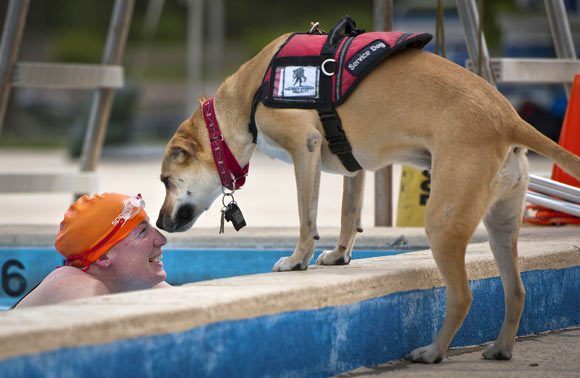Dogs are able to detect an odor collected from patients during an epileptic seizure, according to a study by researchers from Medical Mutts, a service dog organization in Indianapolis, IN, and the University of Rennes in France.

Epileptic patients release a particular smell during a seizure and dogs can be trained to detect it. Image credit: Skeeze.
Epilepsy is a neurological disorder that affects over three million Americans of all ages. Every year, close to 150,000 new people are diagnosed with this disease.
Most patients with epilepsy control their seizures with drug therapy and surgery. About 30-40% of people, however, are resistant to the treatment and continue to have seizures.
The risk of sudden death for epileptic patients is 24 times greater than in the general population. This is a scary and difficult condition to live with as seizures can occur unexpectedly, and can severely impact a person’s life.
Up until now, service dogs helping patients with epileptic seizures were mostly trained to respond to a seizure.
The seizure itself is the cue for the dog to perform a prescribed task and assist the person. Some dogs, however, have shown a natural ability to react before a seizure. They might start licking the person frantically, pacing or whining.
These dogs alert a person to the fact that a seizure is coming, so they can lie down in order to be safe during an episode.
But what the dogs detected was unclear and without that information, it’s impossible for a trainer to replicate the situation and teach dogs to alert before a seizure.
What has made seizure detection so difficult is that there are several types of seizures and several factors that can cause them. It has therefore been unclear whether different people, with different types of seizures, would release the same smell if indeed there is a smell associated with the condition at all.
“In the present study, we hypothesized that there may be a seizure-specific olfactory component that would be common to different individuals and types of seizures,” explained lead author Dr. Amélie Catala from the University of Rennes and colleagues.
“We tested this hypothesis by using a validated protocol which consisted of presenting to trained dogs complex odors (breath and sweat) obtained from each epileptic patient during a seizure, outside a seizure (calm activity) or during sports sessions (to test for a potential sweat specificity).”
Five dogs trained by Medical Mutts were presented samples collected from five patients in a French hospital. The patients suffered different types of seizures.
For each patient, one sample was collected during a seizure, two were collected right after physical exercise and four samples were collected at different times while the person was resting.
All the dogs tested came from rescues and shelters and were in the process of being trained as service dogs for either diabetes alert, seizure alert or psychiatric conditions.
“Our results show that these dogs were clearly able to discriminate the seizure samples from the same patient outside seizures and for all patients tested,” the researchers said.
“This demonstrates for the first time that there is indeed a seizure-specific odor across individuals and types of seizures.”
“Such results make an important contribution to the field of epileptic research with the potential of a specific odor signature that could be detected prior to a seizure.”
The findings appear in the journal Scientific Reports.
_____
Amélie Catala et al. 2019. Dogs demonstrate the existence of an epileptic seizure odour in humans. Scientific Reports 9, article number: 4103; doi: 10.1038/s41598-019-40721-4







